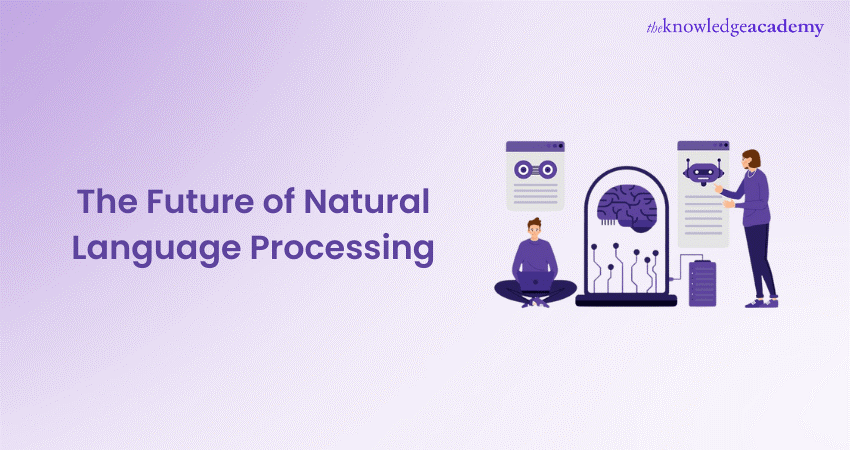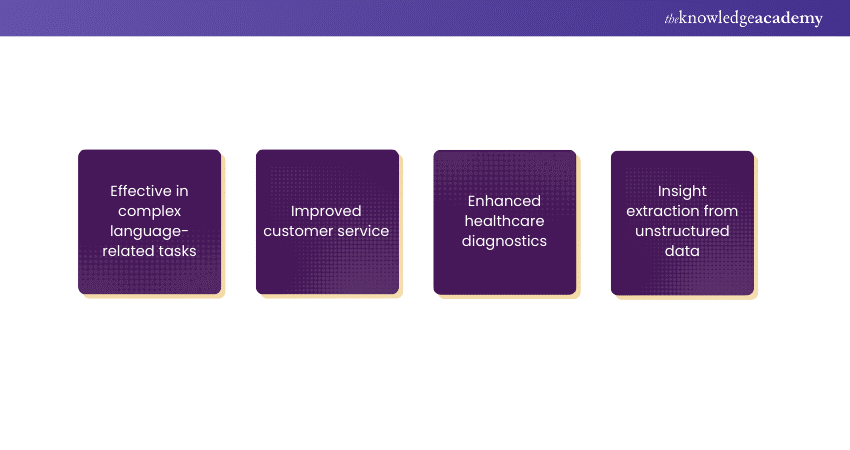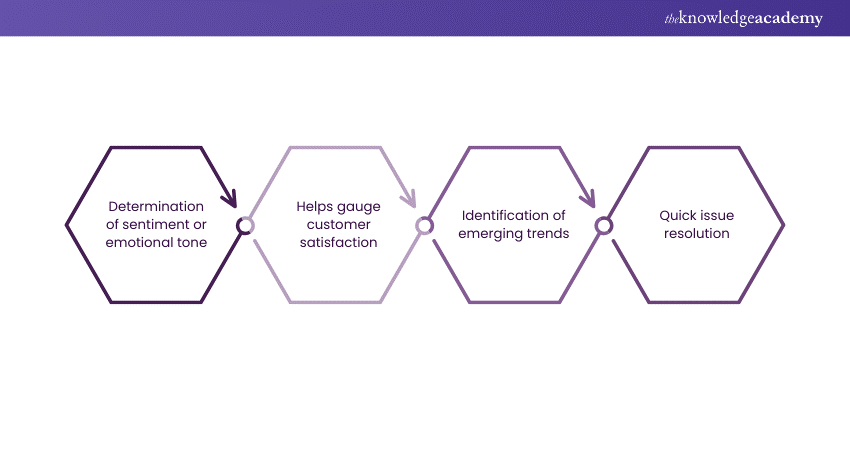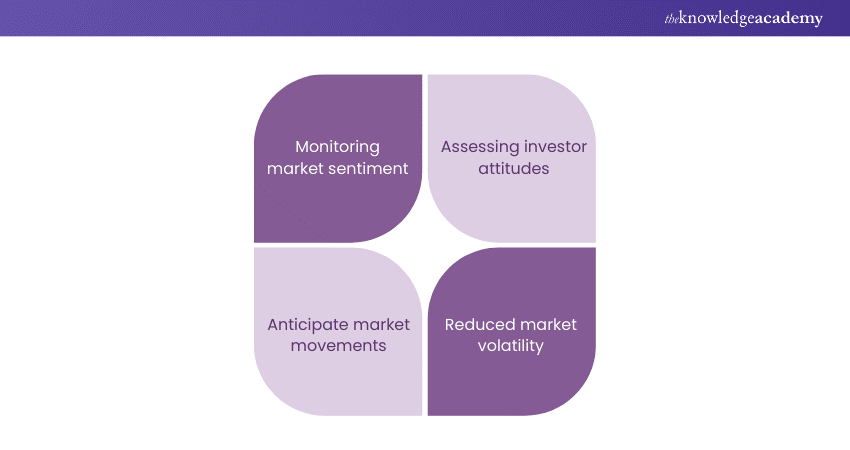We may not have the course you’re looking for. If you enquire or give us a call on + 1-866 272 8822 and speak to our training experts, we may still be able to help with your training requirements.
Training Outcomes Within Your Budget!
We ensure quality, budget-alignment, and timely delivery by our expert instructors.

The Future of Natural Language Processing (NLP) stands as a beacon of technological innovation, promising transformative changes in how we communicate and interact with machines. As a critical subset of Artificial Intelligence (AI), NLP is rapidly evolving, empowering machines to understand, interpret, and generate human language with unprecedented accuracy and sophistication. Explore this blog on the future of Natural Language Processing (NLP) which holds exciting possibilities with ongoing advancements and emerging trends.
Table of Contents
1) What is NLP?
2) Future of Natural Language Processing
a) Continued surge in investments for NLP
b) Transitioning from Human-computer Interaction to Conversational Interfaces for improved service desk responses
c) Enterprise exploration of NLG for text generation
d) Growing adoption of sentiment analysis across diverse industry sectors
e) Advancements in humanoid robotics
f) Increasing ubiquity of voice biometrics
3) Growing adoption of sentiment analysis across sectors
a) Finance
b) HR
c) E-commerce
4) Conclusion
What is NLP?
NLP represents an AI application focused on analysing natural languages, constituting a method for interacting with intelligent systems using human language. Its practical implementation is evident in virtual assistants like Siri, Google Assistant, and others.
Despite being non-human entities, these assistants simulate human-like communication, a feat enabled by NLP. This capability involves teaching machines to comprehend, interpret, and respond to human language, facilitating communication about various issues.
The fusion of linguistics and computer science underpins NLP's ability to decode structured language patterns and develop machine learning models capable of understanding and dissecting key aspects of sentences. The NLP process typically comprises seven fundamental steps:
a) Segmentation: Breaking down complex sentences into smaller segments.
b) Tokenisation: Dividing simple sentences into individual words or tokens.
c) Stop words removal: Eliminating insignificant words like "and," "the," and "is" from sentences.
d) Stemming: Teaching machines a basic set of data within sentences that convey similar meanings, enhancing system awareness.
e) Lemmatisation: Infusing words with emotions and moods to enable machines to grasp the emotional context of sentences and generate appropriate responses.
f) Speech tagging: Educating machines on fundamental grammar terms such as nouns, verbs, and prepositions, and assigning each word in a sentence its respective grammatical role.
g) Named entity tagging: Identifying important nouns, particularly human figures like actors, within documents and tagging them for further reference.
Future of Natural Language Processing
NLP stands as a swiftly advancing domain with extensive applications across diverse industrial sectors. Its surge in popularity within these sectors can be attributed to the exponential growth of AI-driven technology.
Despite the rapid advancement of machine-generated solutions, there are instances where human-like thinking is essential for generating uniquely viable solutions. By integrating NLP into AI frameworks, we enable seamless communication with machines, facilitating input provision and decision-making processes that closely mimic human cognition.
Moreover, this fosters a friendly interaction between machines and humans, allowing for collaborative problem-solving and the extraction of remarkable outcomes. Forecasts suggest that in the foreseeable future, NLP applications will prominently feature in critical sectors such as healthcare.
It will then streamline the organisation of medical records for easy retrieval; cybersecurity, where it will manage the complexities of big data; and the military, where it will bolster system confidentiality, among others.
a) Continued surge in investments for NLP

The continued surge in investments for Natural Language Processing (NLP) reflects a growing recognition of its transformative potential across various industries. As NLP technologies evolve and demonstrate their effectiveness in addressing complex language-related challenges, investors are increasingly drawn to opportunities in this field.
One driving force behind the increased investment in NLP is the expanding scope of its applications. From improving customer service through chatbots to enhancing healthcare diagnostics through clinical text analysis, NLP is proving its versatility and value across diverse sectors.
Furthermore, the rise of big data and the increasing demand for automation solutions have further fuelled investment in NLP. Businesses are keen to leverage NLP to extract insights from vast amounts of unstructured data and automate tasks traditionally performed by humans.
This not only improves efficiency but also provides new avenues for innovation and competitiveness. Moreover, recent advancements in NLP, such as transformer models and pre-trained language representations, have captured investors' attention by promising even greater capabilities in understanding and generating natural language.
As a result, venture capitalists, private equity firms, and tech giants alike are pouring resources into NLP startups and research initiatives, driving the continued growth of investments in this exciting field.
b) Transitioning from Human-computer Interaction to Conversational Interfaces for improved service desk responses
The transition from traditional human-computer interaction (HCI) to conversational interfaces represents a significant paradigm shift in service desk responses, promising enhanced user experiences and efficiency.
Now in the past, HCI primarily involved users interacting with computers through graphical user interfaces (GUIs) or command-line interfaces (CLIs), which often required specific commands or actions to accomplish tasks.
However, conversational interfaces leverage natural language processing (NLP) and artificial intelligence (AI) to enable more intuitive and human-like interactions between users and computer systems.
Conversational interfaces, like chatbots and virtual assistants, mimic human conversation by understanding and responding to user queries and commands in natural language. This transition not only simplifies the user experience but also enables more efficient and personalised service desk responses.
More importantly, users can interact with conversational interfaces using familiar language, making it easier to communicate their needs and receive relevant assistance. Moreover, conversational interfaces offer the potential for real-time assistance and 24/7 availability, improving accessibility and responsiveness for users seeking support or information.
By integrating NLP-powered conversational interfaces into service desk operations, organisations can streamline support processes, reduce response times, and ultimately enhance overall customer satisfaction. As businesses continue to prioritise user-centric experiences, the transition to conversational interfaces represents a strategic move towards more effective and engaging service desk interactions.
c) Enterprise exploration of NLG for text generation
The enterprise exploration of Natural Language Generation (NLG) for text generation represents a strategic endeavour aimed at automating the production of human-like written content. NLG is a essential branch of artificial intelligence (AI) that involves generating coherent and contextually relevant text from structured data inputs.
Moreover, enterprises across various industries are increasingly turning to NLG to streamline content creation processes, improve efficiency, and enhance communication with customers and stakeholders.
One key advantage of NLG is its ability to produce large volumes of personalised, high-quality content at scale. By leveraging algorithms to interpret and synthesise data, NLG systems can generate reports, articles, product descriptions, and other textual content tailored to specific audiences or contexts.
This not only saves time and resources but also ensures consistency and accuracy in messaging. Furthermore, NLG enables enterprises to unlock insights from data by transforming raw data into actionable narratives.
By automatically generating textual summaries or explanations of data insights, NLG facilitates decision-making processes and enhances understanding across the organisation. Moreover, the adoption of NLG empowers enterprises to deliver relevant content to their audiences.
Whether it's dynamically generated marketing campaigns, personalised product recommendations, or interactive chatbot conversations, NLG enables enterprises to create compelling experiences that resonate with customers and drive business outcomes.
d) Growing adoption of sentiment analysis across diverse industry sectors

The growing adoption of sentiment analysis across diverse industry sectors signifies a fundamental shift in how businesses understand and respond to customer feedback and market trends. Sentiment analysis, a subset of natural language processing (NLP), involves analysing text data to determine the sentiment or emotional tone expressed within it.
This technology enables organisations to extract valuable insights from customer reviews, social media conversations, surveys, and other textual sources. In the retail sector, sentiment analysis helps companies gauge customer satisfaction, identify emerging trends, and make data-driven decisions regarding product development and marketing strategies.
By analysing customer reviews and social media mentions, retailers can quickly address issues, improve products or services, and enhance brand reputation. In the financial services industry, sentiment analysis is utilised to monitor market sentiment and sentiment towards specific financial products or companies.
By analysing news articles, social media posts, and other textual data sources, financial institutions can anticipate market movements, identify investment opportunities, and manage risk more effectively. Similarly, sentiment analysis is gaining traction in healthcare, where it aids in understanding patient satisfaction, detecting adverse reactions to medications, and monitoring public health concerns.
By analysing patient feedback, reviews of medical treatments, and social media discussions, healthcare providers can improve patient care and service delivery. Overall, the growing adoption of sentiment analysis across diverse industry sectors underscores its value in informing decision-making, enhancing customer experiences, and gaining competitive advantage in today's data-driven business landscape.
As businesses continue to identify the importance of understanding and responding to customer sentiment, the demand for sentiment analysis solutions is expected to further accelerate.
e) Advancements in humanoid robotics
Advancements in humanoid robotics have reached remarkable heights, pushing boundaries in mimicking human-like behaviour and interaction. These robots, designed with human-like appearances and capabilities, are revolutionising various sectors, from healthcare to manufacturing.
Recent breakthroughs include enhanced mobility, dexterity, and sensory perception, enabling robots to navigate complex environments and perform intricate tasks with precision. Moreover, advancements in AI and machine learning empower humanoid robots to learn and adapt to dynamic situations, fostering seamless integration into everyday life.
As research and development in this field continue to accelerate, the potential for humanoid robotics to revolutionise industries and enhance human lives is boundless.
f) Increasing ubiquity of voice biometrics
The increasing ubiquity of voice biometrics reflects a growing reliance on voice as a secure means of authentication. Voice biometrics utilise unique vocal characteristics to verify individual identities, offering a convenient and secure alternative to traditional authentication methods.
With the proliferation of voice-enabled devices and services, such as virtual assistants and banking apps, voice biometrics have become more prevalent in various sectors, including finance, healthcare, and telecommunications.
Advancements in ML and signal processing have improved the accuracy and reliability of voice biometric systems, making them an integral component of modern security protocols and enhancing user experiences with seamless and frictionless authentication processes.
Growing adoption of sentiment analysis across sectors
Sentiment analysis, leveraging natural language processing, is increasingly adopted across sectors. From retail to finance and healthcare, businesses utilise it to extract insights from customer feedback, social media, and surveys. Enhancing decision-making, it gauges sentiment trends, boosts customer satisfaction, and aids in market monitoring, shaping strategic responses.
a) Finance

In finance, sentiment analysis is swiftly adopted to monitor market sentiment and gauge investor attitudes towards assets or companies. By analysing news articles, social media posts, and financial reports, institutions can anticipate market movements, identify emerging trends, and assess investment risks.
This technology aids in making informed decisions, improving portfolio management, and minimising market volatility. Additionally, sentiment analysis enables financial institutions to enhance customer service by promptly addressing concerns and adapting products to meet evolving consumer preferences.
b) HR
In HR, sentiment analysis is increasingly adopted to gauge employee satisfaction, engagement, and sentiment towards organisational policies or initiatives. By analysing employee feedback, social media posts, and surveys, HR departments can identify potential issues, improve workplace culture, and address concerns proactively.
Moreover, this technology aids in talent management, employee retention, and fostering a positive work environment. Additionally, sentiment analysis enables HR professionals to tailor strategies and interventions to enhance employee well-being and productivity effectively.
c) E-commerce
In e-commerce, sentiment analysis is gaining traction to understand customer opinions, preferences, and sentiments towards products or services. By analysing customer reviews, social media conversations, and online discussions, e-commerce companies can gain insights into consumer satisfaction, identify emerging trends, and optimise marketing strategies.
Furthermore, this technology aids in improving product offerings, enhancing customer experiences, and increasing brand loyalty. Additionally, sentiment analysis enables e-commerce businesses to address customer concerns promptly and personalise recommendations to meet individual needs effectively.
Extract valuable information from raw data by signing up for our Natural Language Processing (NLP) Fundamentals With Python now!
Conclusion
In conclusion, the Future of NLP holds immense promise, with advancements poised to revolutionise how we interact with technology and each other. As NLP continues to evolve, its impact across industries will shape a more connected, intelligent, and efficient future, enhancing communication and driving innovation worldwide.
Frequently Asked Questions

Absolutely, Natural Language Processing (NLP) has tremendous scope. As technology advances, so does the demand for efficient human-computer interaction and language understanding. NLP applications span various sectors like healthcare, finance, customer service, and more.

Without a doubt, Natural Language Processing (NLP) is poised to be the next big thing. As society becomes increasingly reliant on digital communication, the demand for intelligent language processing systems skyrockets. NLP is positioned to revolutionise how we interact with technology, making it a pivotal force in shaping the future.

The Knowledge Academy takes global learning to new heights, offering over 30,000 online courses across 490+ locations in 220 countries. This expansive reach ensures accessibility and convenience for learners worldwide.
Alongside our diverse Online Course Catalogue, encompassing 17 major categories, we go the extra mile by providing a plethora of free educational Online Resources like News updates, Blogs, videos, webinars, and interview questions. Tailoring learning experiences further, professionals can maximise value with customisable Course Bundles of TKA.

The Knowledge Academy’s Knowledge Pass, a prepaid voucher, adds another layer of flexibility, allowing course bookings over a 12-month period. Join us on a journey where education knows no bounds.

The Knowledge Academy offers NLP Training, including courses such as NLP Foundation and Practitioner Training, Neuro Linguistic Programming, Master Diploma in NLP and more. These courses cater to different skill levels, providing comprehensive insights into How to use NLP for Insomnia.
Our Business Skills Blog covers a range of topics related to NLP, offering valuable resources, best practices, and industry insights. Whether you are a beginner or looking to advance your Business Skills, The Knowledge Academy's diverse courses and informative blogs have you covered.
Upcoming Data, Analytics & AI Resources Batches & Dates
Date
 NLP Foundation Course
NLP Foundation Course
Mon 6th Jan 2025
Mon 10th Mar 2025
Thu 8th May 2025
Thu 10th Jul 2025
Thu 11th Sep 2025
Thu 6th Nov 2025







 Top Rated Course
Top Rated Course



 If you wish to make any changes to your course, please
If you wish to make any changes to your course, please


